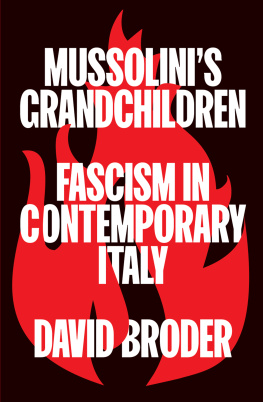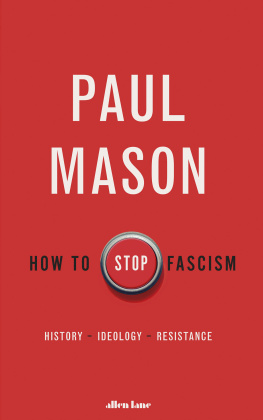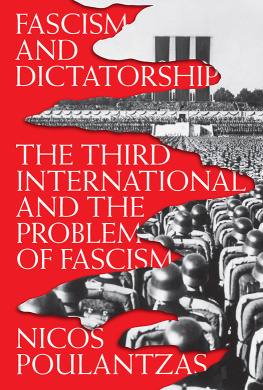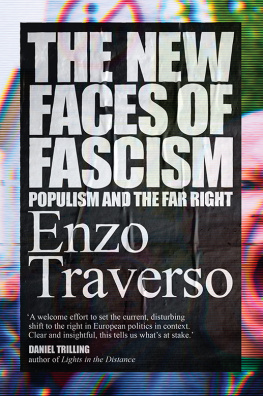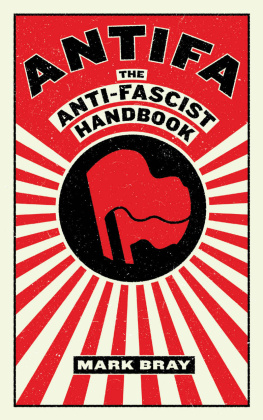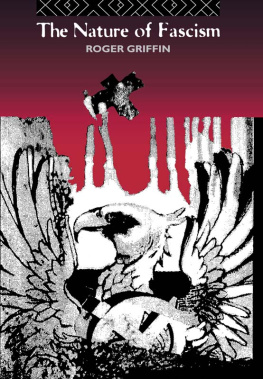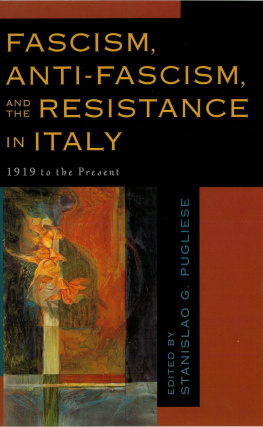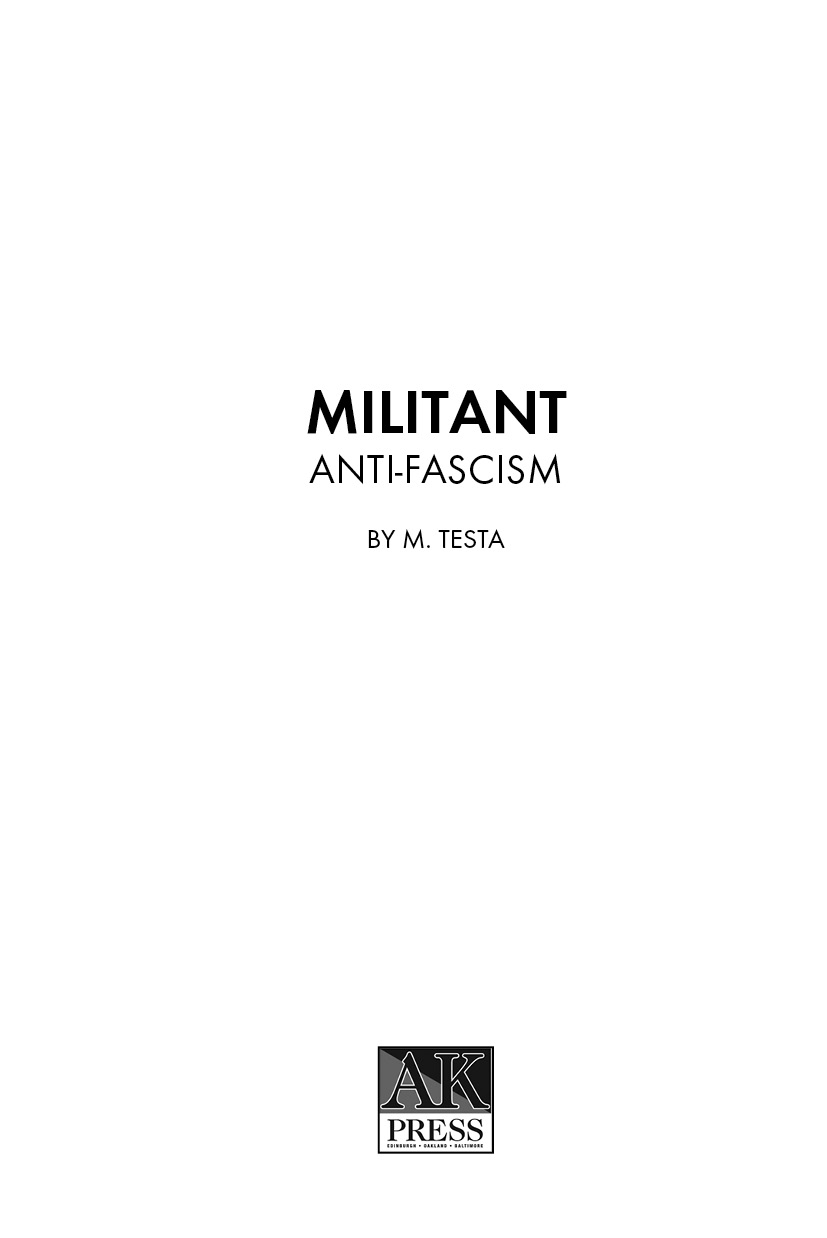Acknowledgements
Anti-fascists from all over the UK and beyond helped us out with information and personal accounts, all inspiring, some hilarious, and others unprintable. Our thanks go out to: AFA Ireland, the Archivist at AFA Archive online, Bish, Brenda, Callum, Matt Collins, Simon Davies, EDL News, Sonia Gable (62 Group), Tony Greenstein, Larry OHara, Rachael Horwitz, Steve L., Matt, LiamO, Louise P., the Red Action archive online, Rosa, TAL Fanzine , Top Cat, Steve Tilzey, Liam Turbett, and especially John Penney for his time, input, and contributions. Thanks to the hundreds of people who supported the blog. And many apologies if we forgot anyone.
Preface
The aim of this book is to give an overview of anti-fascist activity in mainland Europe from the late-nineteenth century to 1945, and in the UK from the 1920s to 2014. The book is for contemporary anti-fascists who want to increase their knowledge of the subject, those who may not be aware of the long history of resistance that they are part of, and especially the new generation of anti-fascists who have mobilised against the English Defence League and their splinter groupuscules. It is also for those studying the subject in an academic context as well as those who have been active against fascism for some time. We hope that the victories and struggles of anti-fascists past and present can inspire and energise militants.
The book aims to show the how the racism, misogyny, anti-Semitism, gangsterism, homophobia, militarism and essentially anti-working-class nature of fascist and ultra-nationalist organizations, are adapted by different organizations, as well as their opportunist collaborations with bourgeois democrats.
Unlike some of the (all too few) books on militant anti-fascism in the UK, such as Beating The Fascists (both versions), No Retreat , Physical Resistance , and Anti-Fascist , this book offers a broader historical context for militant anti-fascists by initially looking to other countries outside the UK and over a longer period of time.
We have admittedly given a subjective overview of militant working-class opposition to fascism. Martha Gellhorn, an anti-fascist who wrote about her experiences during the Spanish Civil War as well as the Second World War, once stated that she had no time for all that objectivity shit. There is no point in denying our bias here: how can we be objective about fascism and what it ultimately leads to?
Militants are often criticised by liberal anti-fascists for being as bad as the fascists, and we do not deny our support for the use of violence, but only when necessary and as a tactic along with the dissemination of information, organization inside the workplace and outside, and the defence of our communities from the divisive actions of the far right.
Militant anti-fascism is often a defensive strategy, although it can quickly mobilise numbers to take the initiative, denying political space for fascists. In the times when fascism is in temporary abeyance, as Red Action once said, instead of being wound up, it was more pragmatic to wind [militant anti-fascism] down to a level appropriate to the nature of the challenge now being offered by the far right. Something that the sudden emergence of the English Defence League and the relatively slow organization of militant anti-fascists demonstrated all too well. We learn from our histories.
Finally, we are hoping that this book will be augmented by a second volume on anti-fascism post-1945 in the USA and Canada, as well as on mainland Europe, especially in Greece, Hungary and Russia where militant opposition to fascism can become a matter of life and death.
M. Testa, 2014.
Endnotes:
Sean Birchall, Beating the Fascists: The Untold Story of Anti-Fascist Action (London: Freedom Press, 2010), 88.
Introduction
This history of militant anti-fascism has, in part, been excavated from the orthodox histories of fascism in order to produce a coherent anti-fascist narrative. We celebrate the activities and achievements of militants in Europe from the late-nineteenth century to the present day, and we make no apologies for advocating the use of physical force as part of a political strategy. Anti-fascism can be proactive as well as defensive, and we have, with considerable help from militants past and present, identified three of the successful elements in the century of struggle against fascism: physical resistance, political organization and propaganda. The use of physical activity to confront or pre-empt fascist activity, along with organization within the workplace, local communities, and links with other working-class organizations, can present a successful opposition. The maintenance of an anti-fascist media presence, particularly in the digital realm, to put forward the arguments for militancy, to publicise activities and successes, to expose fascists, and to encourage others to join the struggle, be it in print media, music, or social networking sites on the net, all are important. We do not advocate one form of action above another; people must use whatever tactics they see as appropriate. Militant anti-fascism also argues for a non-partisan approach wherever possible whilst recognising that popular fronts have met with mixed success and that liberal anti-fascists cannot be relied on most of the time. Neither can the law.
Anti-fascism
There are several identifiable kinds of anti-fascism: militant, state legislative, and liberal. Militants cannot rely on state legislation against fascism, as it will inevitably be used against anti-fascists; urging the state to ban far-right groups and activities merely supplies a pretext for banning radical left ones. The state, in its bid for self-preservation, legislates against extremism of any kind. Anti-fascists need to organise themselves to defend against fascist incursions into their communities, not ring the cops.


